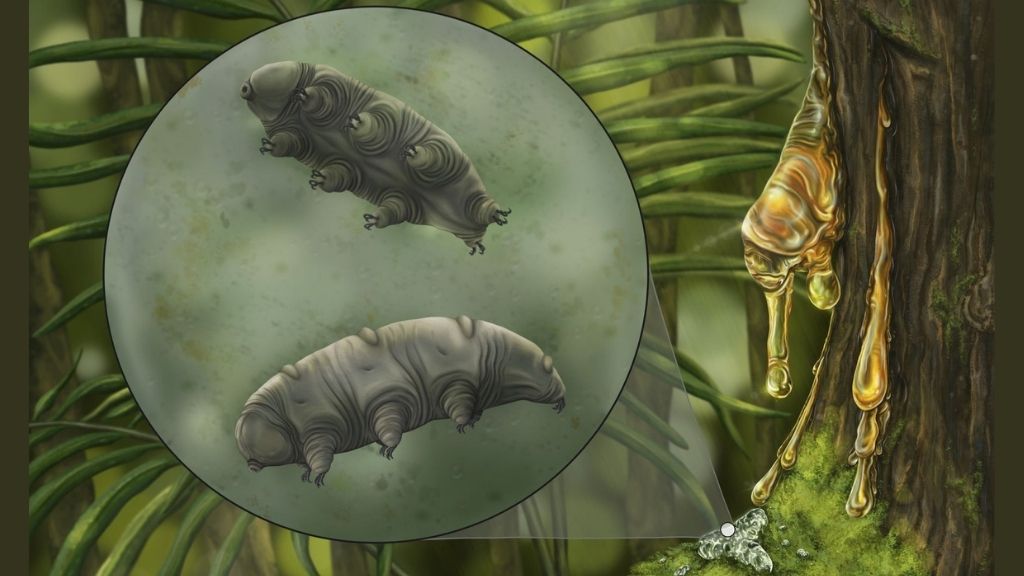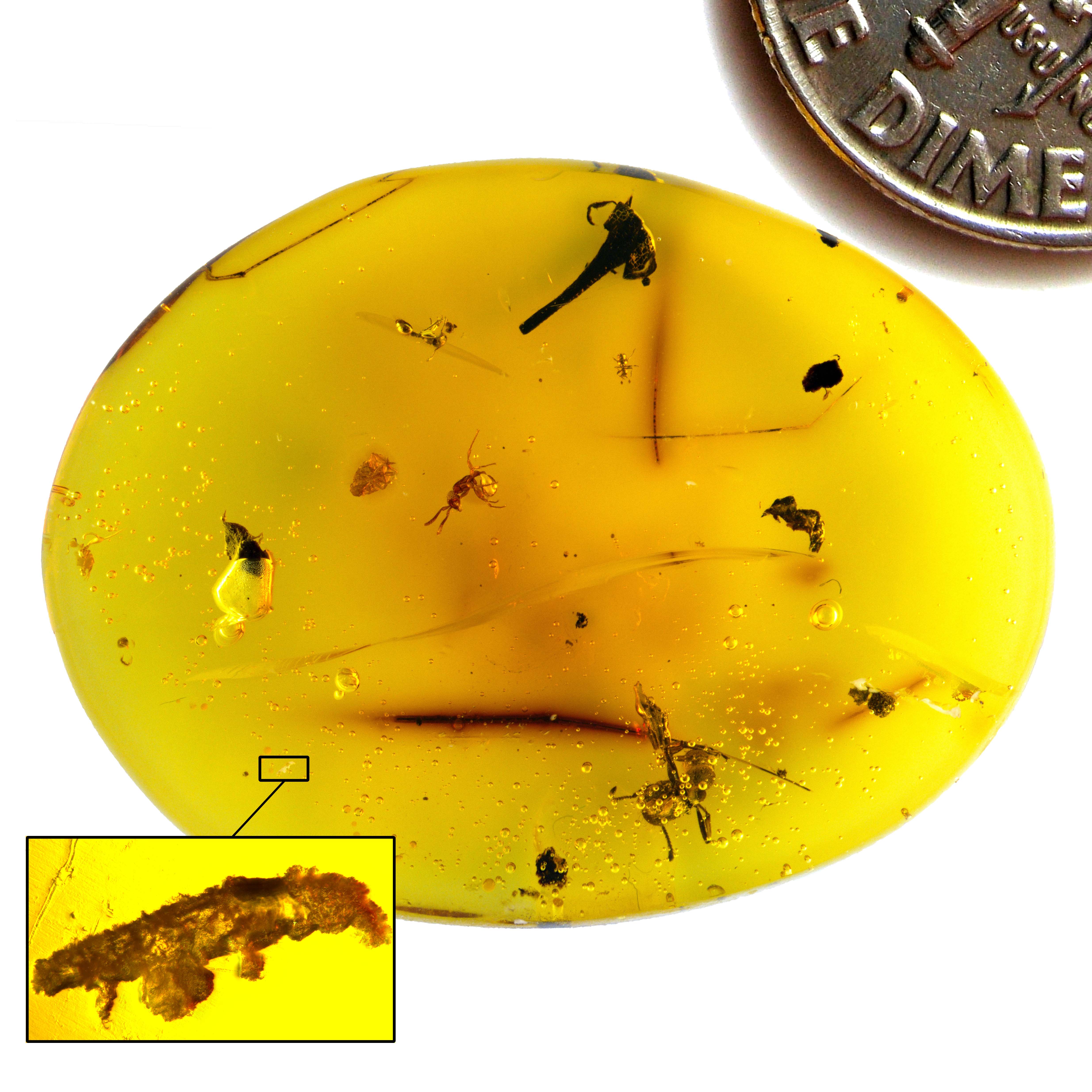Tardigrade trapped in amber is a never-before-seen species

Scientists discovered an incredibly rare fossil suspended in 16 million-year-old amber: a never-before-seen species of tardigrade, a pudgy, aquatic critter that rarely crops up in the fossil record.
Modern-day tardigrades, also known as water bears or moss piglets, can be found in just about any environment with liquid water, from the depths of the ocean to the thin water films that coat terrestrial mosses. The tiny creatures are famous for their survival skills; by expelling most water from their bodies and drastically slowing their metabolism, tardigrades enter a state akin to suspended animation in which they can withstand extreme temperatures, pressure and radiation.
But although tardigrades are nearly impossible to destroy when alive, their small size and lack of hard tissue mean that very few tardigrade fossils have ever been discovered — only three, to be exact. The species of two of these fossils, found in Canada and New Jersey, have been formally named; the other, found in West Siberia, remains unnamed.
Related: 8 reasons why we love tardigrades
But now, in a new study published Tuesday (Oct. 5) in the journal Proceedings of the Royal Society B: Biological Sciences, scientists have introduced a newfound species of tardigrade that they discovered in amber from the Dominican Republic. The fossil dates to the Miocene epoch (23 million to 5.3 million years ago) and is so well preserved that the team was able to place the newfound water bear, named Paradoryphoribius chronocaribbeus, within the tardigrade "tree of life."
"There's really only two clear tardigrades from the fossil record," referencing the two fossils whose species are known, "so this is really exciting to find a third," said Frank Smith, an evolutionary developmental biologist and assistant professor at the University of North Florida who was not involved in the new study. And thanks to the quality of the fossil, the researchers were able to apply the same techniques used to identify living tardigrades, which helped the team determine how the newfound species relates to modern-day water bears, Smith said.
The tardigrade measures less than 0.02 inches (0.6 millimeters) long, so how did the researchers spot it? It was really a matter of luck, first author Marc Mapalo, a doctoral student in the Department of Organismic and Evolutionary Biology at Harvard University, told Live Science.
Get the world’s most fascinating discoveries delivered straight to your inbox.
Mapalo's collaborators at the New Jersey Institute of Technology initially acquired the amber to look for ants captured in the material; the team, led by evolutionary biologist Phillip Barden, studies the evolution of social insects such as ants and termites.
"They'd had the amber for months, but they'd only been looking at ants," Mapalo said. But at some point, a sharp-eyed lab member noticed a stumpy, caterpillar-like shape with teeny, clawed legs jutting out of its underside. Lo and behold, they'd found a tardigrade floating in the amber, alongside three ants, a beetle and a flower.

"It was more luck that they saw it … because it's not something they look for," Mapalo said. Upon learning about the fossil, Mapalo said he was "really surprised," since the chances of finding a tardigrade fossil are so slim. As someone who loves water bears so much that he once wrote a song about them, he was eager to examine one of the few known tardigrade fossils.
In addition to finding the fossil, the team lucked out in that the tardigrade sat fairly close to the surface of the amber, meaning that light from their microscopes could easily reach the sample. Using techniques called transmitted light and confocal fluorescence microscopy, the researchers examined both the external anatomy, such as the tardigrade's claws, and some internal morphology, including various hard structures found in the critter's foregut — roughly akin to its "throat."
Related: Ancient footprints to tiny 'vampires': 8 rare and unusual fossils
"This is the first tardigrade fossil where we were able to visualize the internal morphology," Mapalo said.
Based on the shape and placement of the tardigrade's claws, the researchers identified the water bear as part of the Isohypsibioidea superfamily, a diverse group of modern-day tardigrades. This makes P. chronocaribbeus the oldest known member of the superfamily.
However, aspects of the water bear's internal anatomy set it apart from related tardigrades. In particular, a hard structure located between the mouth and esophagus, called a macroplacoid, bore a unique shape; whereas other Isohypsibioidea members have two to three thick macroplacoids, the new tardigrade fossil had only a single thin one, marked with a ridge.
"Because of this, it does not correspond to any extant genus within this superfamily," Mapalo said. And for this reason, the team created a brand-new genus and species to accommodate P. chronocaribbeus.
In its heyday, P. chronocaribbeus probably lived in similar conditions to modern-day water bears, hanging out on moss cushions and slurping liquid from plant cells, Smith said. "If we went back 16 million years to this locale, we'd probably find this species all over the place." And in theory, more tardigrade fossils might be lurking in Dominican amber from the same region, as well as in other amber deposits around the world, he said.
As of now, very few people are on the lookout for tardigrade fossils in amber, so if more scientists joined the hunt, more tardigrade fossils might be found, Mapalo said.
To the naked eye, "I don't even know if it'd look like a speck of dust; you probably wouldn't see it at all," Smith said. So to spot the pudgy sea critters, scientists would need to carefully inspect all their amber samples under a microscope. But generally speaking, "if you find amber, more than likely, there were tardigrades living somewhere near the tree that was producing that amber … So it's worth looking in any amber sample for tardigrades," he said.
Until more tardigrade fossils are found, Mapalo plans to study the genetic and molecular mechanisms that drive growth and development in living tardigrades. Currently, he's visiting Smith's lab in Florida to study how tardigrade claws develop; this line of research could help reveal what forces drove tardigrade evolution, causing tardigrades to adopt the familiar, plump body plan we now know and love.
In addition, Mapalo wants to study the first fossil tardigrade ever found, which happens to be housed at Harvard. The fossil, identified as the species Beorn leggi, was found in 1964 near Cedar Lake in Manitoba and is about 78 million years old, meaning it dates to the Upper Cretaceous, the authors noted in their report. Because high-resolution imaging techniques were not available at the time, however, the water bear's exact relationship to modern-day species has yet to be determined.
Originally published on Live Science.

Nicoletta Lanese is the health channel editor at Live Science and was previously a news editor and staff writer at the site. She holds a graduate certificate in science communication from UC Santa Cruz and degrees in neuroscience and dance from the University of Florida. Her work has appeared in The Scientist, Science News, the Mercury News, Mongabay and Stanford Medicine Magazine, among other outlets. Based in NYC, she also remains heavily involved in dance and performs in local choreographers' work.


